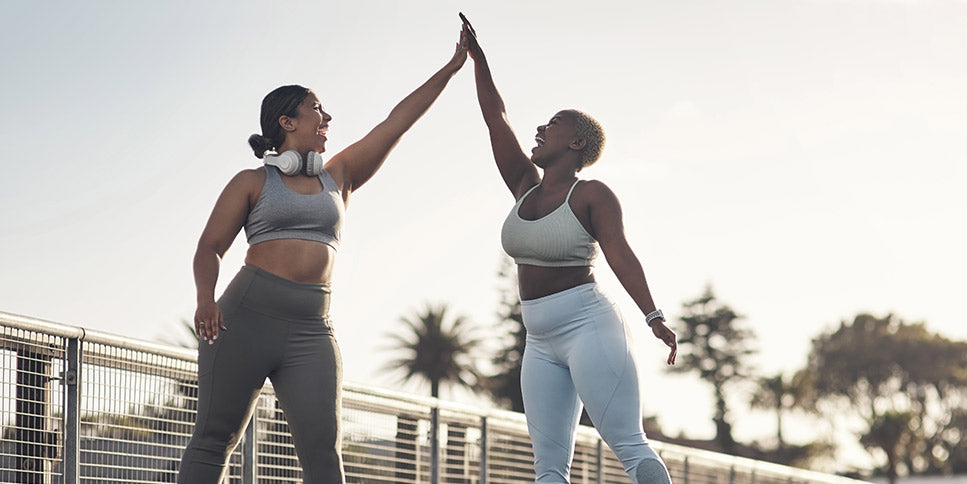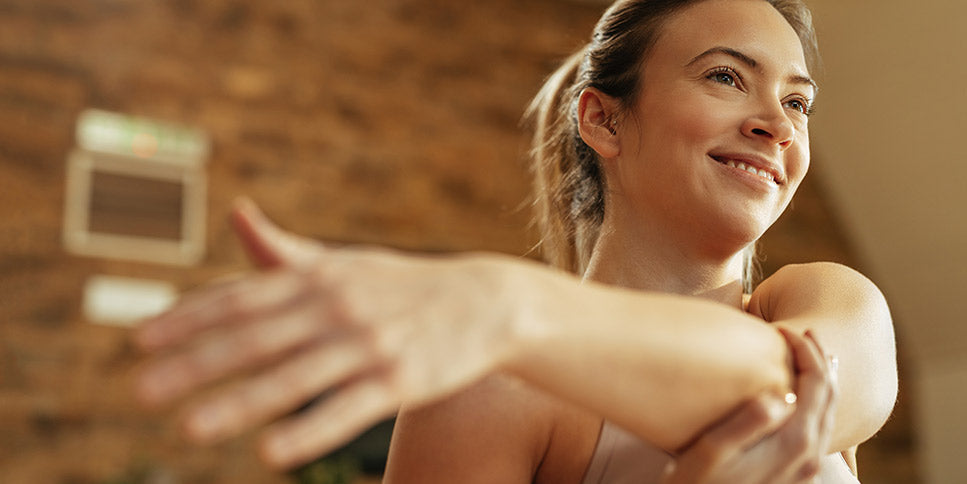There are lots of reasons why people skip their planned workouts. From feeling “too tired” (56% of people) to the weather outside being “too bad” (28% of people), there’s no shortage of excuses when it comes to finding creative ways to get out of working out, according to a survey.
However, there’s one major reason why women skip workouts that’s often overlooked. And it’s due to the size of their breasts. Researchers have found that “breasts were the fourth biggest barrier for women when it came to exercise, only after energy, time, and health.”
Problems With Exercising When You Have A Large Chest
Out of 1,500 women surveyed with a cup size D and above, “60% honestly admitted that at some point in their lives they felt that they couldn’t take part in exercise or sport because of their boobs.”
This makes a lot of sense, especially after a study, “The experience of breast pain (mastalgia) in female runners of the 2012 London Marathon and its effect on exercise behavior,” concluded that, “Mastalgia was experienced by a third of marathon runners and was found to be related to breast size which has previously been unreported.”
Meanwhile, another study, “Does breast size affect how women participate in physical activity?” found that participants with large breasts participated in less vigorous-intensity physical activity compared to participants with small and medium breasts.
“Breast size should be acknowledged as a potential barrier to women participating in physical activity,” the study concluded. “Strategies to assist women with large and hypertrophic breasts participate in all types and intensities of physical activity are needed so women can enjoy the health benefits associated with an active lifestyle.”
Since studies show that the struggle is real for women with large breasts when it comes to exercising, here are some ways to make exercise easier if you have a large chest.
6 Ways To Make Exercising Easier If You Have A Large Chest
Exercise has been shown to decrease estrogen levels and improve breast tenderness. However, exercise has also been shown to be one of the causes of breast pain. Talk about the ultimate Catch-22 for women with big breasts – you’re damned if you do exercise, and you’re damned if you don’t exercise.
That’s why it’s so important for you to adjust your health and fitness program in order to make it easier for you to exercise on a regular basis without experiencing any breast pain. So, here are six ways to make exercising easier if you have a large chest.
1. Wear A Well-Fitting, Supportive Sports Bra Whenever You Exercise
If you’re thinking, Obviously, tell me something that I don’t know! Well, then, did you know that the first sports bra, which was created in 1977, was actually two jock straps sewn together? Or did you know that over 80% of women have been reported to be wearing the wrong bra size?
In order to reduce breast pain while exercising, and even while just doing everyday activities, it’s crucial for women of all breast sizes to wear correctly fitting breast support. So, before you begin any new fitness program, make sure to find a high-quality sports bra with adequate breast support.
A study, “An analysis of movement and discomfort of the female breast during exercise and the effects of breast support in three cases,” examined the movement of the female breast tissue since breast pain is mainly associated with the movement of breast tissue. The clinical trial quantified the movement of the female breast tissue in four conditions – using a sports bra, a fashion bra, a crop top, and no bra while doing four different types of physical activity – running, jogging, marching, and walking.
“The data indicates that adult females should wear appropriate breast support to reduce perceived breast discomfort or pain,” according to the clinical trial. “Of the three garments examined in this study, the fitted sports bra provided superior support and pain reduction.”
A recent study also found that running in the wrong size bra can shorten your stride by four centimeters, which could add up to running an extra mile over the length of a marathon.
Authors of the “Does breast size affect how women participate in physical activity?” study noted that “some large-breasted women may need to wear two bras simultaneously to gain enough support for comfortable running and high-impact activities.”
Since sports bras tend to lose support over time, experts recommend changing your sports bra after around 30 to 40 washes. You may also need to change your sports bra if your weight changes significantly, too.
Also Read: How to Lose Weight in 8 Weeks?
2. Perform Calorie-Burning Exercises That Don’t Involve Bouncing
The movement of a woman’s breast during exercise can range from 4 centimeters during a walk to 15 centimeters while running. This can cause breast pain, as well as your ligaments to stretch – resulting in long-term sagging. That’s why women with large breasts should consider doing fat-burning exercises that don’t involve bouncing.
For example, women who haven’t been exercising due to the size of their breasts may want to start back up with their fitness routine by doing a low impact activity such as walking.
And as long as you can find a comfortable swimsuit with a built-in bra, swimming is another good low impact activity to try, especially since the buoyant forces of the water slow down the downward movement of the breasts and lessen breast-related discomfort.
To swap high-intensity moves for lower-impact movements that work the same muscles, you can do star squats instead of jumping jacks, or you can remove mountain climbers from your weightless workout and add in the up-down plank.
To do star squats, stand with your feet a few inches wider than your hips, with your toes turned slightly out and your arms extended over your head. While looking forward and keeping your chest high, bend your knees and lower your arms out to your sides until your fingertips reach your toes. Then, while pressing through your heels, reverse the movement to complete one repetition.
To do an up-down plank, begin in a full plank on your hands. Then lower your right elbow to the ground and then your left, coming into an elbow plank. Next, put your right hand on the ground, and straighten your right elbow. Then put your left hand on the ground, and straighten your left elbow in order to return to a full plank.
3. Make Dietary Changes That Can Support Health And Ease Breast Pain
Breast pain, or mastalgia, affects 70% of women at some point in their life, especially women between the ages of 30 years old and 50 years old. The two types of breast pain are cyclic mastalgia (cyclic breast pain) and noncyclic mastalgia (noncyclic breast pain).
Cyclic mastalgia is the most common type of breast pain, especially for women 20 years old to 50 years old, and occurs before your menstrual cycle. You may experience breast pain in one or both of your breasts roughly a week before your period. And while the breast pain will go away naturally once you get your period, it will return during your next menstrual cycle.
Noncyclic mastalgia is more common in women between the ages of 40 years old and 50 years old, and has nothing to do with your menstrual cycle. Potential causes of noncyclic mastalgia may be due to an infection, inflammation, pregnancy, and having larger breasts. Noncyclic breast pain can also be caused by smoking, breastfeeding, stress, and caffeine consumption.
So, eliminating caffeine and eating a low-fat diet are two dietary changes that may potentially help to ease breast pain.
Eliminating Caffeine: While eliminating caffeine (found in coffee, tea, cola, and chocolate) from your diet may help reduce breast tenderness, it may take six months (or more) for you to feel the difference in your breasts.
Eating A Low-Fat Diet: Since estrogen is linked to breast pain, eating a low-fat diet, which is especially low in saturated fats, can decrease estrogen levels and improve breast pain and lumpiness. So, try to eat more fish, tofu, and non-fat dairy, and also do your best to avoid meat and dairy products. It’s also a good idea to keep a log of the foods and activities that lead to your breast pain, or that worsen your breast pain. Then you can create a meal plan that suits your active lifestyle.
Research is mixed as to whether your breasts will decrease in size as you exercise more and eat healthier. “Clinicians make recommendations for women to lose weight to reduce breast size, but this may not always be appropriate,” according to researchers at the University of Portsmouth Research Group in Breast Health (RGBH). “Our study showed that to lose the amount of breast tissue that’s removed during surgery, a woman would have to lose 51 kilograms or 70% of her body weight.”
4. Work On Improving Your Posture
Large breasts place additional strain and pressure on your neck, back, and shoulders, which can result in pain. The force created by your breasts can also pull your trunk forward, making you slouch. This can potentially lead to poor posture, which will make your upper back, shoulder, and neck problems even worse.
So, women with large breasts should do core exercises to improve their posture, as well as upper body boosters and shoulder workouts in order to strengthen the muscles of their upper back and shoulders.
5. Work Out With A Friend
If your large chest makes you feel self-conscious at the gym, consider working out with a friend. Exercising with a friend can make working out more fun, increase your chances of you sticking to your exercise plan, and keep you motivated.
You should also know that what you’re feeling is very real, and that you’re not alone. In fact, one survey revealed that 1 in 3 people under the age of 35 years old report that self-consciousness is stopping them from signing up at the gym at all.
So, if you don’t have a friend to workout with, or your friend has to skip an exercise session, make an awesome gym playlist to listen to during your solo workout session.
6. Make Post-Exercise Recovery And Self-Care A Top Priority
If you are experiencing breast pain after working out, you can use a hot or cold compress on your breasts to try to relieve the pain.
You can also experiment with different relaxation techniques after you exercise in order to help the high levels of anxiety associated with severe breast pain. Meditation, massage, deep breathing, yoga, and tai chi are some popular relaxation techniques to consider.
Safe & Effective Weight Loss Products
Hydroxycut is safe for healthy adults to use as directed on the label.


